Ultimate Maintenance Tips for Foldable Bikes
Foldable bikes provide a convenient and versatile mode of transportation, especially for those living in urban environments or with limited storage space. However, like any other bicycle, they require consistent maintenance to ensure optimal performance, safety, and longevity. This article will guide you through various aspects of foldable bike maintenance, from cleaning and lubrication to inspecting and replacing crucial components. By following these tips, you will not only enjoy smoother rides but also extend the life of your foldable bike.
Introduction to Foldable Bike Maintenance
Introduction:
Foldable bikes are a great investment for those who need a space-saving and portable transportation option. These versatile bicycles can be taken with you on public transportation, stored in tight spaces, and easily maneuvered through busy streets. But just like any other bicycle, foldable bikes require regular maintenance to ensure they run smoothly and safely. This guide will help you familiarize yourself with the various parts of a foldable bike and the necessary tools for maintaining it.
Step 1: Know Your Foldable Bike Parts
Getting to know the different parts of your foldable bike is essential in order to carry out proper maintenance. Familiarize yourself with the following components:
- Frame – The main structure that holds the bike together.
- Hinge mechanism – The key component that allows the bike to fold and unfold.
- Wheels – Fitted with tires, rims, and spokes; they enable your bike to move smoothly.
- Tires – The inflatable, rubber outer part of the wheels that provide cushioning and grip.
- Brakes – The mechanism responsible for stopping or slowing down the bike.
- Gears – The system that allows for different speeds and easier or harder pedaling.
- Chain – Connects the pedals to the gears and is responsible for transferring your pedaling power to propel the bike.
- Seat and seat post – Provides a comfortable place to sit and can be adjusted to suit your height.
- Handlebars – Allows you to steer and control the bike.
Step 2: Gather Essential Tools
Before starting any maintenance tasks, gather all the necessary tools used to ensure a smooth and efficient process:
- Allen wrench set – Used to tighten and loosen bolts on the frame, handlebars, and seat post.
- Bike pump – Ensures proper tire inflation.
- Tire levers – Helps remove and install tires.
- Patch kit – Used to repair any punctures in the inner tube.
- Chain tool – Assists in repairing or replacing the chain.
- Screwdrivers – Allows for adjustments on derailleurs and brakes.
- Lubricants – Keeps gears, chain, and moving parts well-lubricated.
- Cleaning supplies – Rags, brushes, and bike-specific cleaning solutions for a thorough clean.
Step 3: Perform Regular Maintenance
Now that you’re familiar with your bike’s components and have gathered all necessary tools, it’s time to perform the following maintenance tasks regularly:
- Inspect the hinge mechanism for damage or wear. Ensure that the locking mechanism is functioning properly and tighten any loose bolts.
- Check tire pressure and inflate them to the recommended PSI.
- Inspect tires for any signs of wear, damage, or punctures. Replace or repair as needed.
- Adjust and test brakes to ensure they are functioning well. Replace worn brake pads if needed.
- Make sure gears shift smoothly and accurately. Adjust derailleurs and lubricate the chain if necessary.
- Clean and lubricate the chain to prevent rust and ensure smooth pedaling.
- Wipe down the frame, wheels, and other components to keep them clean and free of any debris that can cause damage or affect performance.
Conclusion:
Foldable bikes have become an increasingly popular choice for those living in urban areas or with limited storage space. Proper maintenance is essential to ensure a safe and enjoyable riding experience. By familiarizing yourself with the parts and necessary tools, as well as regularly following the maintenance tasks outlined in this guide, you can help prolong the life of your foldable bike and have confidence in its performance.
Cleaning and Lubrication
Cleaning and Lubrication for Foldable Bikes:
Foldable bikes are an excellent choice for those with limited storage space and who need portability. To keep your bike in top condition, regular maintenance is essential. The following instructions will teach you how to clean and lubricate your foldable bike correctly.
1. Gather your supplies:
- A bucket filled with soapy water
- A soft brush or sponge
- A toothbrush or small brush for tight spaces
- Clean, dry rags or towels
- Bike specific degreaser
- Bike specific chain lubricant
- Bike specific grease (for bearings and other components)
2. Prep your bike:
Unfold your bike and put it in a stand or upside down to keep it stable during cleaning. Remove any accessories or bags to make the process easier.
3. Clean the frame:
Wet your soft brush or sponge in the soapy water, and gently scrub the frame, handlebars, seat post, and other non-moving parts of your bike. Make sure to clean around the hinges and folding mechanisms as dirt and grime can accumulate in these areas. Use the toothbrush or small brush for tight spaces. Rinse your bike with clean water.
4. Clean the chain:
Spray a bike-specific degreaser onto the chain, making sure to cover all links thoroughly. Use the toothbrush or small brush to scrub the chain, removing built-up dirt and grime. Rinse the chain well with clean water. You can also use a chain-cleaning tool to simplify this process.
5. Clean the cassette and derailleurs:
While the degreaser is still wet on the chain, use the small brush or toothbrush to clean the cassette (rear gears) and derailleurs (gear shifting mechanisms). Be sure to remove all dirt and grime as this can affect your bike’s shifting performance.
6. Clean the brakes and wheels:
Use the soapy water and soft brush to clean your wheels, focusing on the brake pads, rims, and spokes. For disc brakes, ensure the rotors are clean and clear of any debris. Rinse the wheels well with clean water.
7. Dry your bike:
Use the clean, dry rags or towels to dry off your bike, ensuring all components, especially the chain, cassette, and derailleurs, are thoroughly dried to prevent rust.
8. Lubricate the chain:
Apply a bike-specific chain lubricant to the chain, ensuring to cover all links and rollers. Rotate the pedals to distribute the lubricant evenly throughout the chain. Wait a few minutes, then use a clean rag to remove any excess lubricant.
9. Lubricate other moving parts:
Apply a small amount of bike-specific grease to other moving parts, such as the pivot points on the derailleurs, shifting levers, and brake levers. This will help prevent wear and tear and keep your bike running smoothly.
10. Reattach any removed accessories, and you’re good to go!
Following these steps will keep your foldable bike in excellent condition, allowing for a smoother and more enjoyable ride. Remember to perform this maintenance regularly, especially after riding in dirty or wet conditions, to prolong the life of your foldable bike and reduce the risk of breakdowns. Regular maintenance will also save you money in the long run, as you’re less likely to need costly repairs.

Checking and Adjusting Brakes
Inspect the Brake Pads
- Before you begin, ensure your bike is in a stable position. It’s best to use a bike stand if you have one, but if not, you can lean it against a wall or turn it upside down, resting it on the seat and handlebars.
- Locate the brake pads on your foldable bike’s braking system. They are usually rectangular or curved rubber pieces that are clamped onto the metal arms and make contact with the wheel’s rim when the brake lever is pulled.
- Inspect the brake pad surfaces for wear. If they appear smooth or unevenly worn, it’s time to replace them. Additionally, check if there’s at least 1/8 inch (3mm) of pad remaining before the metal shoe; if it’s less, you’ll need new brake pads.
Adjust the Brake Pads
- Using an Allen wrench (usually 4mm or 5mm), loosen the brake pad’s mounting bolt. Be careful not to remove it completely—just loosen it enough to adjust the position of the brake pad.
- Align the brake pad with the rim, ensuring that it is parallel and making full contact. The pad should sit about 1/16 inch below the edge of the rim to avoid contact with the tire.
- Squeeze the brake lever and hold the brake pad against the rim in the proper position. While doing this, re-tighten the mounting bolt to secure the brake pad in place. Repeat this process for the other brake pad.
- After adjusting both brake pads, spin the wheel to ensure the brake pads do not rub against the rim or tire while the brakes are not engaged. If they do, you may need to re-adjust their position.
Replace the Brake Pads (if necessary)
- If your brake pads are worn and need replacement, remove the brake pad mounting bolt completely using an Allen wrench.
- Slide out the worn brake pad and replace it with a new one. Make sure to align the new brake pad correctly with the rim, as described in Step 2.
- Re-insert the mounting bolt and tighten it with the Allen wrench, securing the new brake pad in place. Repeat this process for the other brake pad.
- After replacing the brake pads, test the brakes by squeezing the lever and ensuring proper contact and stopping power. You may need to readjust the cable tension for optimal performance.
Periodic inspection and maintenance
Periodic inspection and maintenance of your foldable bike’s brakes are crucial for your safety and the longevity of your bike. By following these steps and adjusting or replacing your brake pads when needed, you can ensure optimal brake performance and a smooth ride.
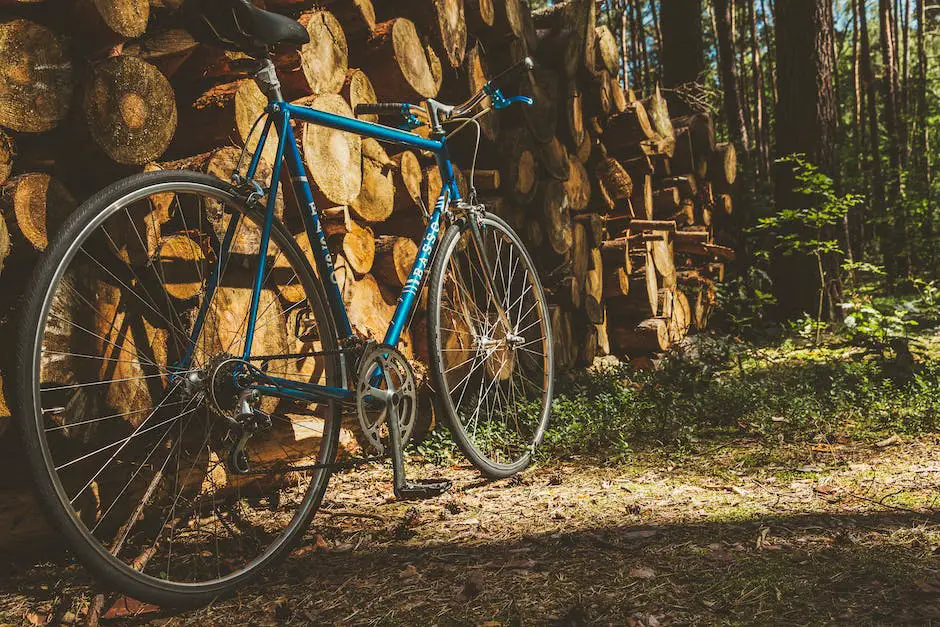
Inspecting and Maintaining Tires
Inspecting and Maintaining Tires for Foldable Bikes
Proper tire maintenance is essential for a smooth and comfortable ride on your foldable bike. It promotes safety by keeping your bike stable, provides better handling, and can extend the life of your tires. By following these instructions, you can easily inspect, maintain, and replace your tires.
Tire Pressure:
- Check the recommended tire pressure written on the sidewall of the tire.
- You should check the tire pressure at least once a week, or before long rides, using a reliable tire pressure gauge.
- Inflate your tire according to the recommended pressure.
- If your tire pressure reads too low, use a bike pump to inflate it until it reaches the proper level.
- If your tire pressure reads too high, release some air by gently pressing the tire valve until the pressure decreases to the recommended level.
- Always replace the valve cap after checking and adjusting your tire pressure.
Signs of Tire Wear:
- Inspect your tires for signs of wear, such as tears, cuts, and cracks on the surface.
- Check the tread of your tires for depth and evenness. An uneven or almost-flat tread indicates that your tire is wearing unevenly and may need to be replaced or aligned properly.
- Look out for small punctures and embedded objects, such as glass or thorns, that could cause your tire to lose air over time.
- If the sidewall of the tire begins to bulge out or shows severe wear, it is time to replace the tire.
Changing a Flat Tire:
- To change a flat tire, you will need a bike pump, tire levers, a patch kit or spare inner tube, and a wrench if your bike does not have quick-release wheels.
- Start by releasing the brakes and removing the wheel from the bike using the quick-release lever or a wrench.
- Use the tire levers to pry the tire off one side of the rim. This will expose the inner tube.
- If you are patching the tube, locate the puncture and follow the instructions on the patch kit. If you are replacing the tube, remove the old tube and insert the new one.
- Inflate the tube slightly to give it shape, and then carefully reposition it inside the tire, ensuring that the valve stem is straight.
- Use your hands or tire levers to guide the tire’s bead back into the rim.
- Inflate the tire to the recommended pressure and reinstall the wheel onto your bike.
Maintaining and Replacing Tires:
- To extend the lifespan of your tires and maintain a smooth ride, rotate them periodically by swapping the front and rear tires.
- Keep your bike tires clean, as dirt and debris can cause increased wear, punctures, and poor performance.
- If you regularly ride on rough terrain or carry a lot of weight on your bike, consider using more heavy-duty tires with thicker tread for increased durability.
- Replace your tires when they show signs of excessive wear or if they do not hold air, as this is essential for your safety while riding.
By following these steps, you can keep your foldable bike’s tires in good condition, providing a better, safer, and more enjoyable riding experience.
Checking and Adjusting Gears
Introduction:
Foldable bikes are an excellent solution for commuters, travelers, and minimalists alike. To ensure your foldable bike runs smoothly and safely, regular maintenance is a must. One critical element of bike maintenance is checking and adjusting the gears. With this guide, you’ll discover how to inspect, clean, lubricate, and adjust your bike’s gears for smooth and efficient gear changes while riding.
Step-by-Step Instructions:
1. Inspect and clean the gears:
- Start by unfolding your bike and shifting to the smallest chainring (front) and smallest sprocket (rear).
- Inspect the chain for signs of wear, rust, or damage. If necessary, replace the chain for optimal performance.
- Inspect the front and rear derailleurs, ensuring they’re clean and undamaged. Use a soft-bristle brush (like an old toothbrush) to remove any dirt or debris.
- Inspect the teeth on the chainrings and sprockets for any damage or unusual wear patterns. Replace any damaged parts as necessary.
Note: It’s essential to clean your bike’s gears regularly, especially after muddy or dusty rides.
2. Lubricate the gears:
- To lubricate the chain, apply bike-specific chain lube while slowly turning the pedals backward. Ensure the entire chain is covered in lube, but avoid over-lubricating, as this can attract dirt and grime.
- Allow the lube to penetrate the chain for a few minutes, then gently wipe off any excess with a clean, lint-free cloth.
- Apply a small amount of bike-specific lube to the pivot points on the front and rear derailleurs. This includes the jockey wheels on the rear derailleur.
3. Adjust gear shifting:
- Shift the bike into the smallest chainring (front) and the smallest sprocket (rear).
- Inspect the front derailleur’s height and alignment. The gap between the derailleur cage (the metal plates that guide the chain) and the chainring teeth should be about 2-3mm. Additionally, the cage should be parallel to the chainring.
- If needed, loosen the front derailleur clamp and readjust the height and alignment. Re-tighten the clamp securely.
- Inspect the rear derailleur’s alignment. The jockey wheels (the two small wheels on the rear derailleur) should be vertically aligned with the smallest sprocket. If they’re not, use a 5mm Allen wrench to loosen the derailleur hanger bolt, align the derailleur, and re-tighten the bolt securely.
- Test the gear shifting by slowly pedaling while shifting through each gear combination. If the chain doesn’t shift smoothly, you may need to adjust the cable tension or limit screws on the derailleurs.
4. Fine-tune cable tension and limit screws:
- If the front derailleur isn’t shifting smoothly, locate the barrel adjuster (a small, usually plastic, circular piece on the derailleur housing) and turn it counterclockwise to increase cable tension or clockwise to decrease it.
- If the rear derailleur isn’t shifting smoothly, locate its barrel adjuster and turn it counterclockwise to increase cable tension or clockwise to decrease it.
- If your bike struggles to shift into the largest or smallest sprockets, you may need to adjust the limit screws (usually marked “H” for high gear and “L” for low gear) on the derailleurs. Turn the appropriate screw to prevent overshifting or undershifting.
Conclusion:
Taking the time to check and adjust your foldable bike’s gears will greatly enhance your riding experience. By following these steps regularly, you can ensure your bike shifts smoothly and efficiently, allowing you to tackle any terrain with ease. Remember always to prioritize safety, and consult a professional bike mechanic if you’re unsure about any maintenance or adjustments.
Maintaining the Folding Mechanism
Maintaining the Folding Mechanism of Your Foldable Bike
Proper maintenance of your foldable bike’s folding mechanism is crucial to ensure smooth folding, safety, and longevity of your bike. By following these instructions, you will understand how to keep your bike’s folding mechanism functioning correctly and efficiently.
1. Get familiar with your folding mechanism:
Start by reading your foldable bike’s owner’s manual, which should provide information on how to fold and unfold the bike correctly. Understand the location and functionality of all the hinges, latches, and other components that make up the folding mechanism.
2. Clean the folding mechanism:
Use a damp cloth to wipe down the hinges, latches, and connecting parts of your folding mechanism, removing any dirt, dust, or grime that may have accumulated over time. Make sure your bike is completely unfolded before cleaning to access all the parts easily.
3. Inspect for wear and damage:
Regularly check the folding mechanism for any signs of wear, corrosion, or damage. Pay special attention to the hinges, latches, and any other components that experience regular movement. Replace any damaged or worn parts as needed to maintain the mechanism’s smooth operation.
4. Lubricate the hinges and latches:
Apply a high-quality bike-specific lubricant or grease to all the hinges, latches, and connecting parts of the folding mechanism. This will help reduce friction, protect against wear, and make the folding process more effortless. Make sure to wipe off any excess lubricant, as too much can attract dirt and impair the mechanism’s operation.
5. Adjust the folding mechanism as needed:
Over time, the latches and hinges on your folding bike may need adjustment to ensure a secure fit. Consult your bike’s owner’s manual for information on how to make these adjustments, or take your bike to a professional service center if you’re unsure about how to proceed.
6. Test the folding mechanism:
After cleaning, lubricating, and adjusting the folding mechanism, fold and unfold your bike several times to ensure it operates smoothly and securely. Check for any unusual noises, excessive resistance, or misalignment, which could indicate further adjustments or repairs are needed.
7. Practice proper folding technique:
Always follow the recommended folding and unfolding procedure for your specific bike, as detailed in your owner’s manual. This will help minimize unnecessary stress on the folding mechanism and reduce the risk of damage.
8. Maintain safety:
Check that all safety features, such as locking mechanisms and safety clips, are functioning correctly every time you fold and unfold your bike. Never ride your bike if you have concerns about the folding mechanism’s security or integrity.
9. Schedule regular maintenance:
Establish a routine maintenance schedule for your folding bike, taking into consideration the manufacturer’s recommendations and your personal usage patterns. Regular maintenance will help extend the life of your folding mechanism and prevent potential issues from surfacing.
By following these steps, you can effectively maintain your foldable bike’s folding mechanism, ensuring smooth folding, safety, and optimal performance.

Inspecting and Replacing Bearings
Inspecting and Replacing Bearings for Foldable Bikes
Bearings play an essential role in ensuring your foldable bike operates smoothly and efficiently. Regular maintenance and inspection of bearings will help keep your bike in optimal condition and save you money on costly repairs. This guide will teach you how to inspect and replace bearings on your foldable bike.
Gather your tools:
- A bicycle repair stand (optional)
- Clean rags or paper towels
- A flat surface to work on
- Degreaser or rubbing alcohol
- Grease
- A set of wrenches or an adjustable wrench
- A bearing press or punch tool
- Replacement bearings (consult your bike’s manual for the proper size and type)
Secure your foldable bike:
Place your bike on a hard, flat surface or in a bicycle repair stand to make it easier to work on. Fold your bike if needed to access the components you’ll be inspecting and replacing (i.e. headset, bottom bracket, or wheel hubs).
Inspect the bearings:
Bearings are located in several areas of your bike, such as the headset, bottom bracket, and wheel hubs. To inspect the bearings, you’ll need to remove the components they’re located in.
- Headset: Remove the handlebars, stem, and spacers to expose the headset bearings.
- Bottom Bracket: Remove the crank arms and spindle to gain access to the bottom bracket bearings.
- Wheel Hubs: Remove the wheels from the frame and take off the axle nuts or quick-release skewers to expose the wheel bearings.
Once you can access the bearings, rotate them to check for smoothness. If they feel rough, gritty, or tight, it’s a sign that they may be damaged or worn and need to be replaced.
Clean and regrease the bearings:
If the bearings aren’t damaged but feel dirty or dry, remove them from the component and clean them thoroughly using a degreaser or rubbing alcohol. Apply fresh grease to the bearings, ensuring that they’re well-lubricated.
Replace damaged bearings:
If the bearings are damaged or excessively worn, you’ll need to replace them. Remove the damaged bearings using a punch tool and a hammer, tapping them gently until they pop out of the component. Be careful not to damage the component itself while removing the bearings.
Install the new bearings:
Using a bearing press or punch tool, gently install the new bearings into the component. Make sure the bearings are seated evenly and flush with the component. Apply some grease to the bearings to ensure smooth operation.
Reassemble the components:
Now that the bearings have been inspected, cleaned or replaced, begin to reassemble the bike components in the reverse order that they were removed. Make sure all fasteners are tightened to the manufacturer’s recommended torque and that everything is properly aligned.
Test your foldable bike:
After reassembling your foldable bike, take it for a test ride to make sure everything feels smooth and functions properly. Listen for any unusual noises or rattling that may indicate a loose component or issues with the bearings.
Remember to regularly inspect and maintain the bearings on your foldable bike to prevent any issues in the future. With proper care, your foldable bike should provide a smooth and enjoyable ride for years to come.
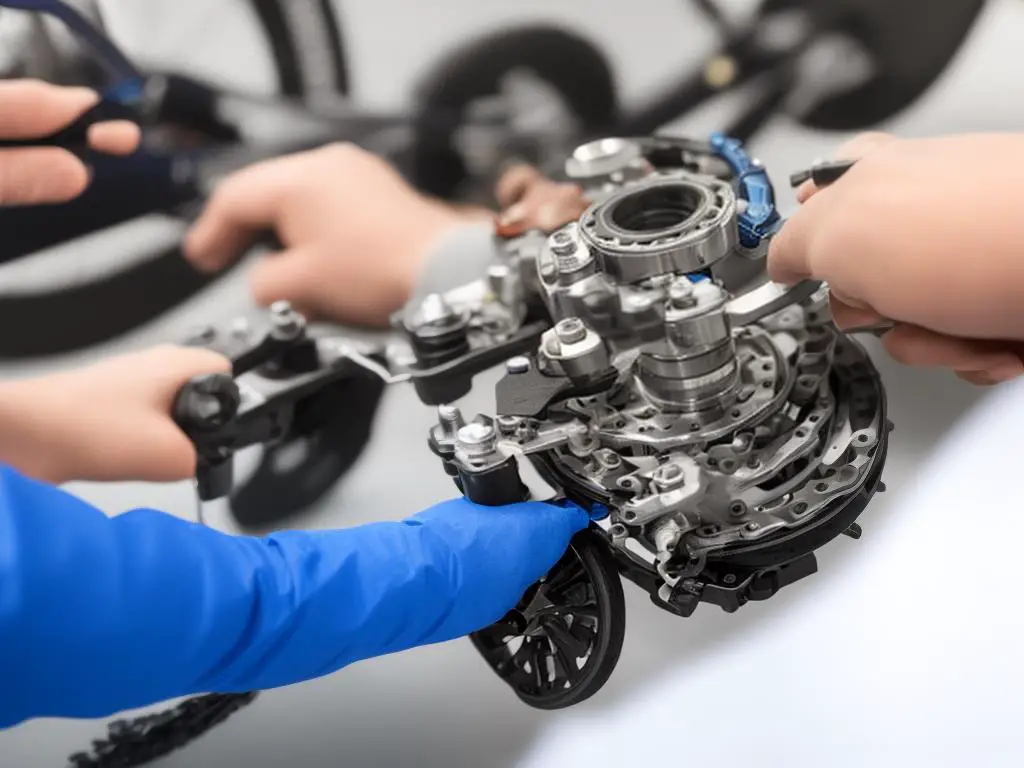
Adjusting and Replacing the Chain
Inspecting the chain for wear and proper tension:
- First, shift your bike into the smallest chainring (front) and the smallest cog (rear) to create slack in the chain.
- Inspect the chain for damaged or missing links, rust, or excessive dirt buildup. A worn chain may have visible gaps between the rollers and the chain links.
- To check chain tension, grab a link in the middle of the chain and lift it upward. The proper tension allows the chain to move up and down about half an inch to an inch. If there is excessive play or the chain feels too tight, you will need to adjust the chain tension.
Cleaning and lubricating the chain:
- With the chain still on the bike, use a chain cleaning tool or a brush and degreaser to remove dirt and grime. If you don’t have a chain cleaner, you can use a toothbrush or a nail brush instead to scrub the chain.
- Rinse the chain with water and let it dry completely.
- Apply a high-quality bike-specific chain lubricant to each link of the chain. Be sure to choose a lubricant that is suitable for your riding conditions (e.g., wet or dry).
- After applying the lubricant, shift through all gears to distribute the lubricant evenly.
Adjusting chain tension:
- To adjust chain tension, first, loosen the bolts securing the rear wheel in place.
- Adjust the position of the rear wheel forward or backward to increase or decrease the chain tension. Make sure the process is done evenly on both sides of the wheel to maintain proper wheel alignment.
- Check the chain tension by lifting a link in the middle of the chain. Ensure there’s about half an inch to an inch of vertical play.
- Once the proper tension is achieved, tighten the rear wheel bolts securely.
Replacing the chain:
- If you find your chain is excessively worn or damaged, you will need to replace it.
- Remove the old chain from the bike using a chain breaker or quick link pliers (if your chain has a quick link).
- Measure the new chain against the old chain and remove any excess links using a chain breaker.
- Install the new chain, threading it through the front chainring, rear derailleur, and cassette. If your new chain has a quick link, connect the chain using the quick link. Otherwise, use a chain breaker to join the ends of the chain.
- Adjust the chain tension (as outlined in step 3) and test for smooth shifting and proper tension.
- Make sure to lubricate the new chain as described in step 2.
Conclusion:
By routinely inspecting, cleaning, and maintaining your foldable bike’s chain, you can ensure a smooth, safe, and enjoyable ride.
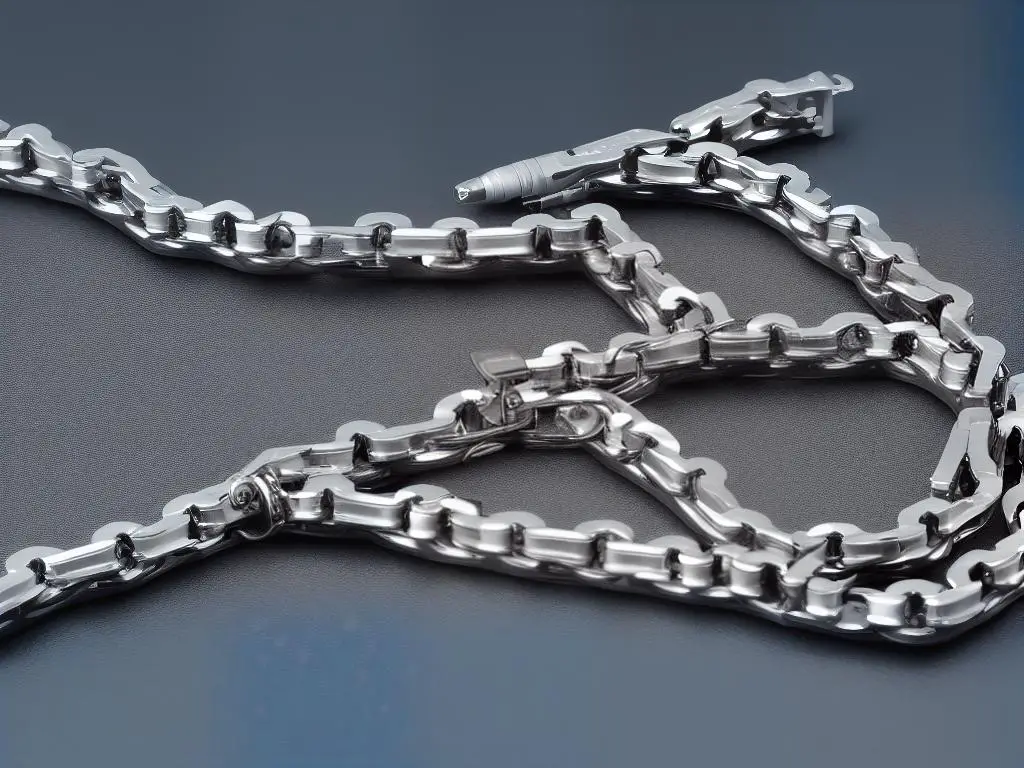
Inspecting and Tightening Bolts
Inspecting and Tightening Bolts on Your Foldable Bike
Regular maintenance is essential for ensuring the safety and performance of your foldable bike. An important aspect of this maintenance is inspecting and tightening bolts. Bolts can loosen over time due to vibration from riding or simply from frequent folding and unfolding of the bike. In this guide, we will walk you through the process of inspecting and tightening the bolts on your foldable bike.
Step 1: Gather the necessary tools
- A set of Allen wrenches (also known as hex keys)
- An adjustable wrench or a set of spanner wrenches
- A clean cloth or rag
Step 2: Inspect the bolts
The first step is to visually inspect all bolts. Carefully examine each bolt and look for any signs of wear, rust, or damage. If you are unsure whether a bolt is up to standard, it’s better to replace it with a new one.
Step 3: Check for loose bolts
Using your fingers, gently try to move each bolt. If it moves or rotates without any resistance, it needs to be tightened. Take note of any bolts that need attention as you go around the bike.
Step 4: Tighten loose bolts
Using the appropriate wrench, tighten any bolts that you identified as loose in Step 3. Apply pressure gently and evenly to avoid stripping or damaging the bolt head. It’s important to not overtighten the bolts, as this can result in damage to the bike’s components. Remember: tighten until snug, but don’t force it.
Step 5: Focus on key areas
Some components of your foldable bike are particularly important to inspect and maintain. Pay special attention to the following areas:
- Seat post clamp: Ensure that the clamp bolt is tight and that the seat post remains securely in place.
- Handlebar and stem: Check that the bolts connecting the handlebars to the stem are tight, as well as the bolts securing the stem to the steerer tube.
- Folding mechanism: Examine the folding clamps, hinges, and quick-release mechanisms for wear and proper tightness.
- Brakes: Inspect the bolts securing the brake calipers, levers, and cables, and ensure they are tight and functioning correctly.
- Wheels: Make sure the bolts attaching the wheels to the frame (located on the axles) are tight.
Step 6: Test ride
After you have inspected and tightened all the bolts as needed, it’s time to take your foldable bike for a test ride. As you ride, listen for any unusual sounds or vibrations that may indicate a loose bolt or other issue. Stop and reinspect if needed.
Conclusion
By following these steps and regularly inspecting and tightening your bike’s bolts, you can prevent potential accidents and ensure a safe and smooth ride on your foldable bike. Remember to also carry out other maintenance tasks, such as cleaning your bike, lubricating the chain, and checking tire pressure, to keep your bike in top condition.
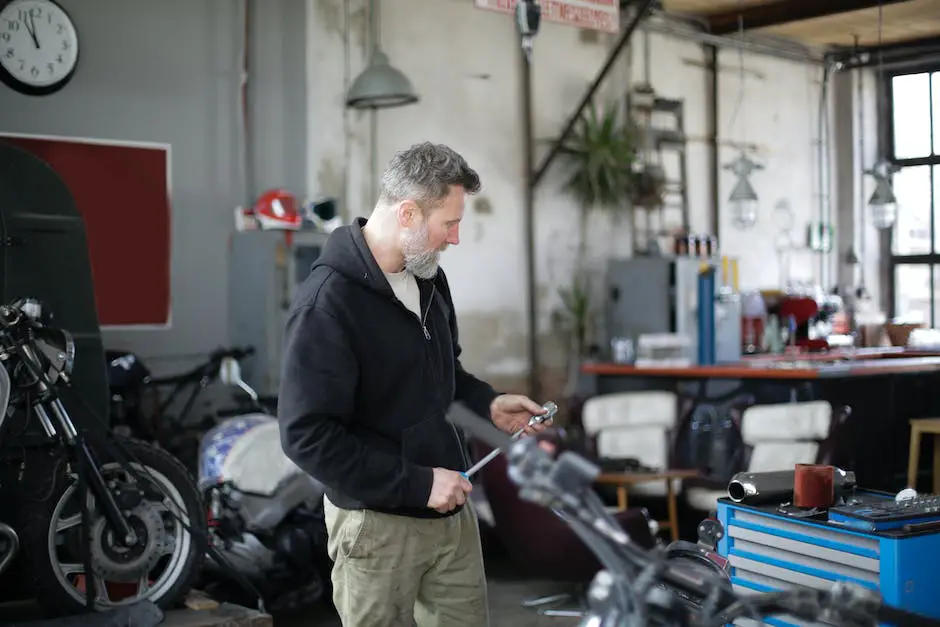
Storage and Transportation Tips
Properly Folding the Bike
Before attempting to store or transport your foldable bike, make sure you know how to fold it correctly, as per the manufacturer’s instructions. Improper folding can cause damage to the bike or make it difficult to unfold later.
Cleaning Before Storing
To prevent rust and maintain the condition of your bike, clean it thoroughly before storing it for an extended period. This will help to remove dirt, mud, and other debris that can corrode or damage the frame and components over time.
Keeping it Dry
Moisture can cause rust and corrosion, so it is essential to store your foldable bike in a dry area. Avoid damp places like basements, and consider using a dehumidifier if necessary. Additionally, if your bike gets wet during a ride, be sure to dry it thoroughly before storing it.
Using a Cover
A bike cover can help protect your foldable bike from dust, moisture, and sunlight when stored indoors. Choose a cover specifically designed for foldable bikes to ensure a proper fit.
Storing it Off the Ground
To prevent damage from accidental knocks or flooding, store your foldable bike off the ground. You can use a wall-mounted bike rack or a storage stand designed for foldable bikes.
Securing it
If you are storing your bike in a publicly accessible location, like a garage or storage facility, be sure to secure it with a sturdy lock to prevent theft.
Invest in a Carrying Case/Bag
A carrying case or bag designed for foldable bikes can make transportation easier, protecting your bike from damage during transit. These cases or bags often have handles or straps for comfortable carrying and are made from durable materials to withstand regular use.
Transporting In a Vehicle
When transporting your foldable bike in a car, make sure it is folded correctly and securely placed in the trunk or back seat. Use a protective mat or blanket to prevent scratches or damage to the car’s interior. Additionally, ensure the bike does not move around while driving. You may use bungee cords or straps to secure it in place if necessary.
Handling The Bike
When lifting and carrying your foldable bike, be mindful of its weight and size. Use proper lifting techniques and avoid lifting from fragile components, such as the bike’s seat or handlebars.
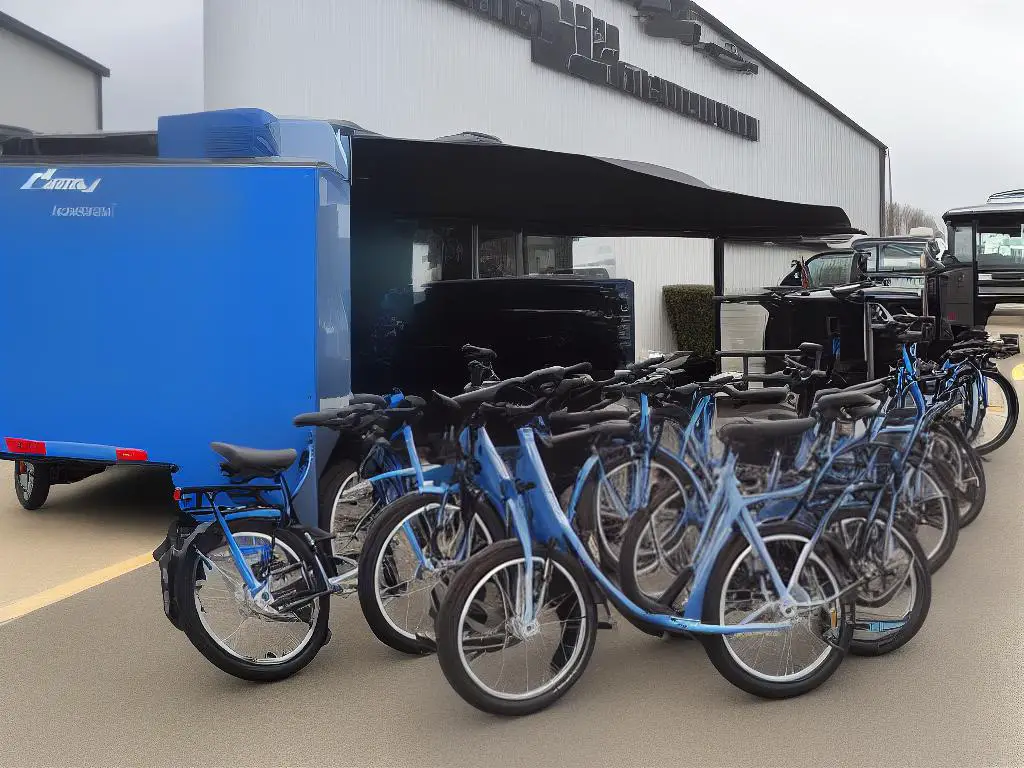
Routine Inspection and Maintenance Schedule
A well-maintained foldable bike
will ensure a smooth and safe ride, as well as prolong the life of your bicycle. Developing a routine inspection and maintenance schedule tailored to your usage frequency and riding environment is essential. Here’s a general guideline to help you in maintaining your foldable bike:
1. Weekly Inspection (for regular riders):
- Frame and Folding Mechanisms: Examine the frame for any cracks, dents or damage, paying special attention to the folding area. Ensure that the folding mechanisms (hinges, latches, etc.) are clean and functioning correctly. Lubricate these parts periodically to ensure smooth operation.
- Tires and Wheels: Check the tire pressure and inflate to the recommended PSI found on the sidewall of your tires. Visually inspect for any cuts or punctures and ensure the tires are in good condition. Spin the wheels to make sure they are true (not wobbly) and that the rims are free of dents.
- Brakes: Test the brakes for proper functioning and make necessary adjustments. Check the brake pads for wear and replace if needed. Also, ensure the brake cables are in good condition and not frayed or sticking.
- Drivetrain: Inspect the chain, gears, and derailleurs for wear and tear or damage. Clean the chain with a degreaser and apply fresh lubricant to help reduce friction and prevent rust. Make sure the gears shift smoothly and adjust if necessary.
2. Monthly Inspection (for occasional riders):
- Perform all the tasks mentioned in the weekly inspection.
- Clean your bike regularly to avoid dirt build-up, especially if you frequently ride in muddy or damp conditions. Use a damp cloth to wipe down the frame and components, and a gentle brush to clean any hard-to-reach areas.
- Check and tighten any bolts and fasteners, including the folding mechanism, to ensure a secure and safe ride.
- Inspect the wheel spokes and ensure they are tight and free of bends or damage.
3. Biannual Inspection (for seasonal or infrequent riders):
- Perform all the tasks mentioned in the weekly and monthly inspections.
- Examine and lubricate all moving parts, such as pedals, brake levers, and derailleur pivots.
- Check the condition of all cables and housing. Replace them if they are worn, frayed, or corroded.
- Evaluate the condition of your bike’s bearings, such as the bottom bracket, headset, and wheel hubs. Ensure they rotate smoothly and service or replace if needed.
Remember to tailor your inspection and maintenance schedule according to your foldable bike’s specific needs, as well as your riding habits and environment. The more effectively you maintain your bike, the better it will perform and the more enjoyable your rides will be.
By following this comprehensive guide, you will not only keep your foldable bike in top shape but also enhance your overall cycling experience. Proper maintenance ensures the longevity of your investment and contributes to a safe and enjoyable ride. With a well-maintained bike in your arsenal, you can commute, explore, and exercise with confidence, knowing that your foldable bicycle is always ready for the next adventure.

